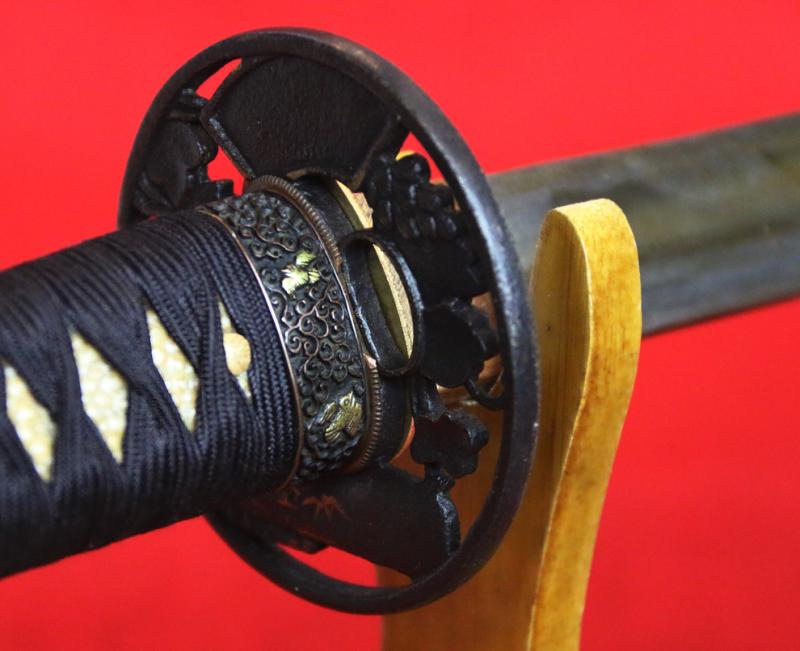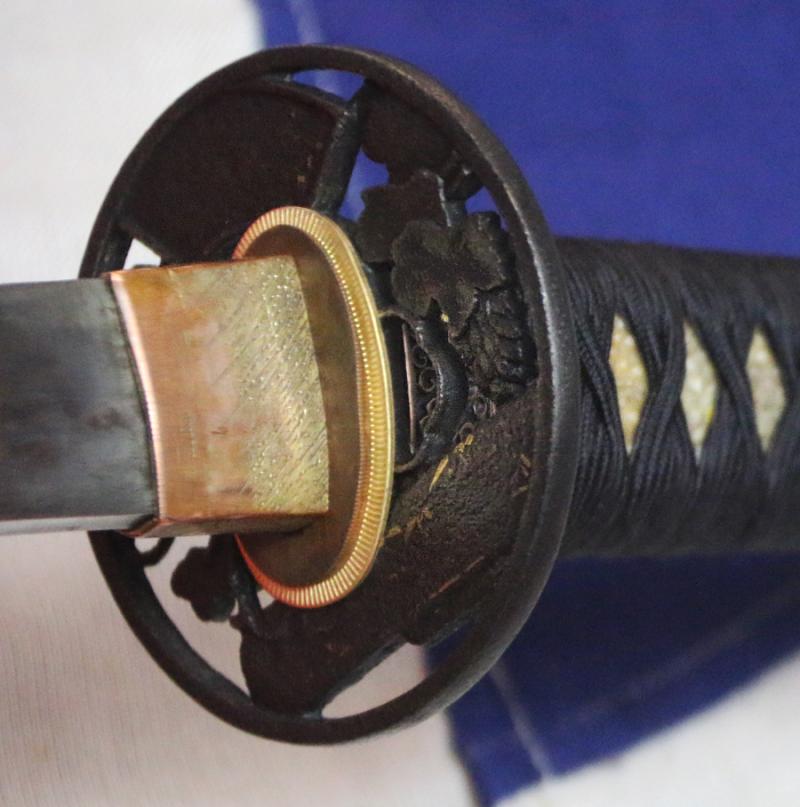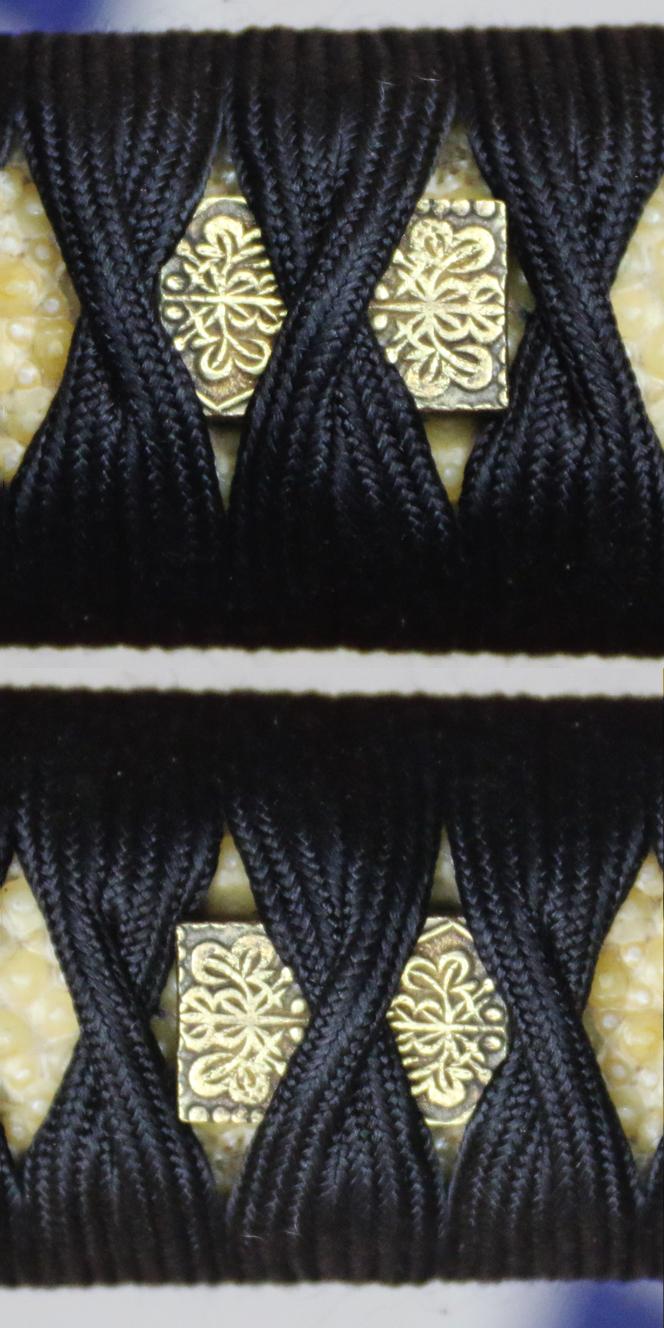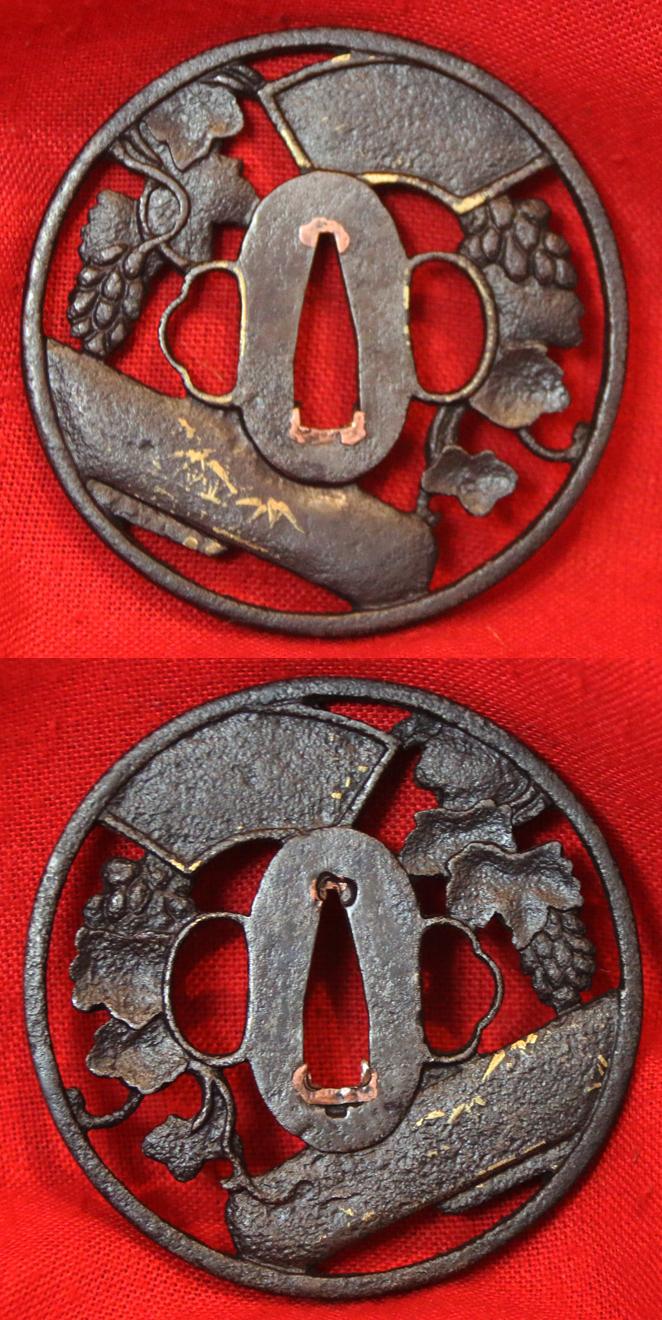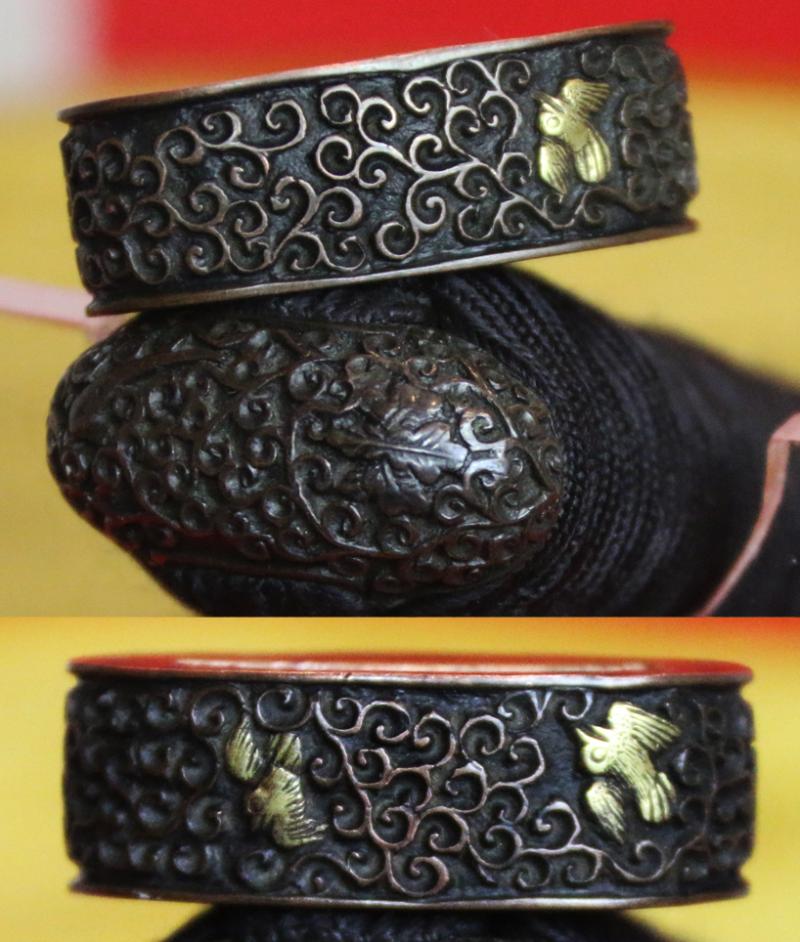Samurai Katana Signed Kaneuji Around 1680, With The Toyatomi Clan & Imperial Kiri Kamon. With a Pair of Edo Ni Bu Ban Kin Rectangular ‘Bar’ Gold Coin Menuki. It Has an Amazingly Beautiful Polished Blade, With A Truly Elegant Curvature.
All original Edo mounts and a very fine original urushi lacquer saya. With most gorgeous Edo fuchi kashira, of very well executed high reliefs of arabesque vines, or karakusa. This style of carving is named Mino-bori it has within the design a kiri clan mon of the empress tree, the symbol of the the Toyotomi clan, that was later bestowed as a great honour to samurai family clan, by the Imperial Court, and the sword has matching kiri clan kamon of a pair of Edo period 2 Bubankin gold coins. The Kiri-mon (paulownia patterns) is a generic name for Monsho (crests or coats of arms) that are based on paulownia. It is also called Toka-mon. Since it was incused on money such as koban (former Japanese oval gold coin) after Muromachi period. A very nice Tetsu, gold inlaid, Bushu school sukashi tsuba.
Toyotomi-shi was a Japanese clan that ruled over the Japanese before the Edo period, and their symbol was the paulownia kiri kamon. The most influential figure within the Toyotomi was Toyotomi Hideyoshi, one of the three "unifiers of Japan". Oda Nobunaga was another primary unifier and the ruler of the Oda clan at the time. Hideyoshi joined Nobunaga at a young age, but was not highly regarded because of his peasant background. Nevertheless, Hideyoshi's increasing influence allowed him to seize a significant degree of power from the Oda clan following Oda Nobunaga's death in 1582. As the virtual ruler of most of Japan, Hideyoshi received the new clan name "Toyotomi" in 1585 from the emperor, and achieved the unification of Japan in 1590.
When Hideyoshi died in 1598, his son Toyotomi Hideyori was only five years old. Five regents were appointed to rule until his maturity, and conflicts among them began quickly. In 1600, Tokugawa Ieyasu deposed Hideyori and took power after winning the Battle of Sekigahara. In 1614, Hideyori came into conflict with the Tokugawa shogunate, leading to Tokugawa Ieyasu's Siege of Osaka from 1614 to 1615. As a result of the siege, Hideyori and his mother, Yodo-dono, committed seppuku in the flames of Osaka castle. After their death, the Toyotomi clan dissolved, leaving the Tokugawa clan to solidify their rule of Japan and the last member of the Toyotomi clan was Tenshuni ja (1609–1645). A rumor said that Toyotomi Hideyori's son Toyotomi Kunimatsu escaped execution, and another rumour said that Hideyori had an illegitimate son named Amakusa Shirō. The Kiri kamon became the Imperial mon and its use was permitted and granted as a mark of great honour by the imperial court and a sign of great favour awarded to a loyal and devoted samurai family
The stunning blade has just returned from artisan re-polishing and looks really,really beautiful.
The original Edo period urushi lacquer on the saya is in simply excellent condition and shows most elegant simplicity, yet a most intricate patterning in the black lacquer. it reveals within that simplicity the finest craftsmanship and beauty worthy of a master of the art of urushi decor. Japanese lacquer, or urushi, is a transformative and highly prized material that has been refined for over 7000 years.
Cherished for its infinite versatility, urushi is a distinctive art form that has spread across all facets of Japanese culture from the tea ceremony to the saya scabbards of samurai swords
Japanese artists created their own style and perfected the art of decorated lacquerware during the 8th century. Japanese lacquer skills reached its peak as early as the twelfth century, at the end of the Heian period (794-1185). This skill was passed on from father to son and from master to apprentice.
The first rectangular gold coin was the Ichibu Ban Kin, or One Bu Size Gold, introduced in 1599. This was long before any of the other forms of Japanese bar money, and it’s uncertain why it originated. Regardless, it circulated all the way through 1869 with a whopping 16 different varieties.
However, the overall design remained consistent throughout the years. Both sides are bordered by raised dots, and the obverse reads “Ichibu” (One Bu), with Kiri crests above and below. These crests represent the flower of the Paulownia tree, the symbol of the Office of the Prime Minister of Japan. The reverse features the signature of Mitsutsugu.
Over the years, they became smaller and were debased, from 85.7% to 57.4% gold. Even with such a long mintage, all varieties of these coins are rare today. Released in 1818, the Ni Bu Ban Kin (Two Bu Size Gold) was intended to make commerce easier. Most of the Koban coins in circulation by that point were broken, and this thicker, stronger rectangular coin was meant to replace them. Damaged Koban coins could be converted for free, provided they weren’t missing too much of their gold content.
However, people were not satisfied. The Ni Bu Ban Kin consisted of lower quality gold and was generally seen as a less reliable coin, so they didn’t see wide circulation. They started with 56.3% gold but were debased to only 22.3% by 1868.
In design, they are almost to the Ichibu Ban Kin. They are larger, of course, and have the denomination “Ni Bu” inscribed on the obverse, but all other elements are the same.
Every single item from The Lanes Armoury is accompanied by our unique Certificate of Authenticity. Part of our continued dedication to maintain the standards forged by us over the past 100 years of trading
39 inches long in saya total. Blade length tsuba to tip, 27.25 inches.
Code: 24373
6450.00 GBP


